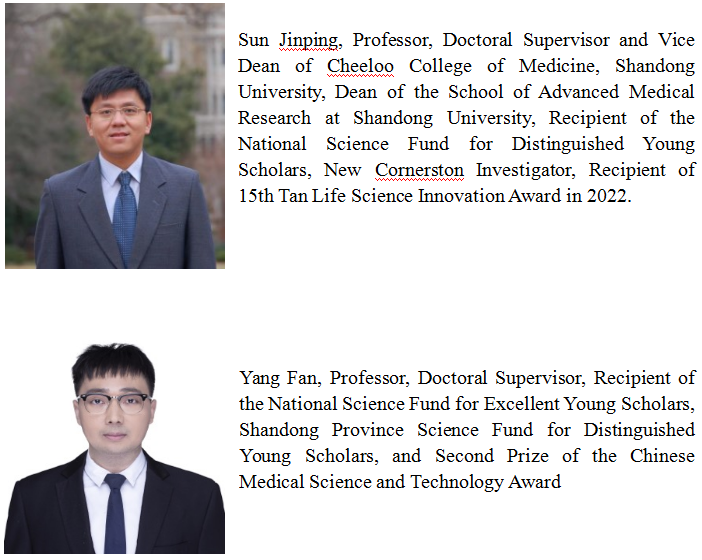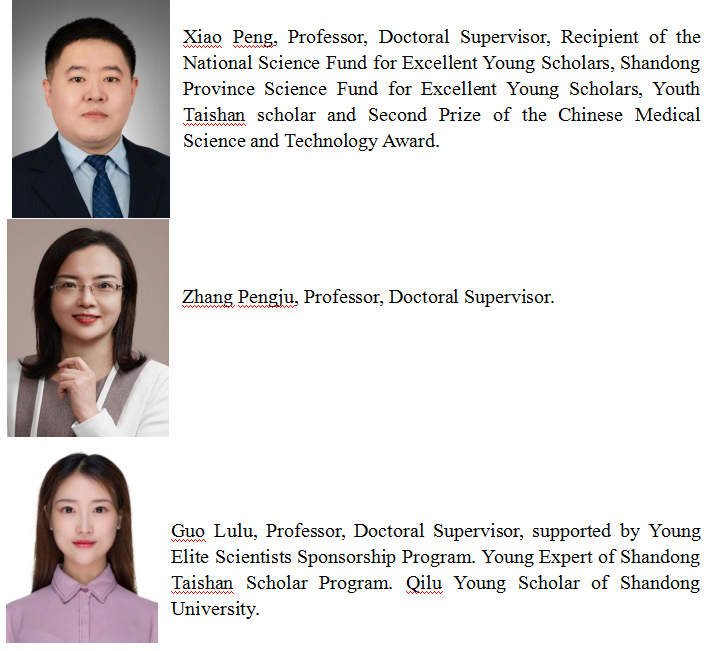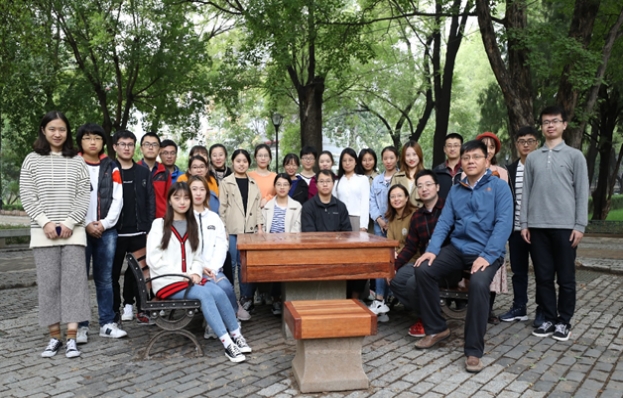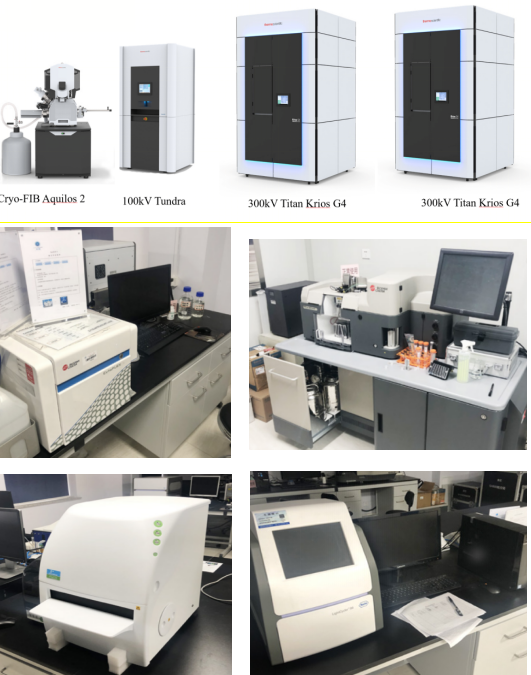Reaserach Direction:
Our research is dedicated to the study of receptor biology and pharmacology.
Establishment and Development:
Jinpeng Sun, the lab founder, engaged in the GPCR study during his postdoctoral research in the lab of Prof. Robert J Lefkowitz (2012 Nobel Laureate in Chemistry, the founder of the GPCR research area) at Duke University.
Education
1998 B.Sc. University of Science and Technology of China (USTC).
2001 M.S. University of Science and Technology of China (USTC).
2007 PhD. Albert Einstein College of Medicine, Bronx, New York. (USA)
Postdoctoral Training
2007-2011 Research Associate.
Advisor: Robert Lefkowitz, James B. Duke Professor of Medicine and Biochemistry and Investigator, Howard Hughes Medical Institute (2012 Nobel Prize)
In February 2011, Dr sun returned to China, and was hired a full-time job at Shandong University, and work as professor and PhD supervisor. Since then, Prof. Sun established the lab of Membrane Receptor and Drug Target with international cultural atmosphere. In 2021, Prof Sun was appointed as executive vice president of the Advanced Medical Research Institute. In 2018, Prof Sun was awarded the National Science Fund for Distinguished Young Scholars in Pharmacology. And since December 2023, Prof Sun took up the position of the executive vice president of Cheeloo College of Medicine, Shandong University.
Sun lab has been conducting research on membrane receptors and drug targets for more than a decade. We have carried out in-depth studies centering on GPCR de-orphanization in sensory system, GPCR ligand discovery and recognition mechanism; GPCR functional diversity and development of functional biased drugs, and achieved a series of original results. (1) We have revealed the coding mechanism of GPCRs for olfactory, itch and force sensation, and explained the basic process of these life activities at the molecular level. (2) We have clarified the molecular mechanism of fatty acid and peptide hormone recognition by GPCR, and developed lead drugs for the treatment of diabetes, obesity, atopic dermatitis, and schizophrenia by targeting these GPCR receptors. (3) We have put forward a series of working models of the GPCR-arrestin signal pathway, and carried out a series of biased drug discovery and development according to these models. The working models of bias signal include: the "flute model" of GPCR receptor phospho-patterns, the theory of polyproline rich region dockine sites and allosteric regulation, and the mechanism of receptor core-induced and ligand-dependent conformational changes in arrestin.function. These models provide a theoretical explanation for the diversity of receptor function selectivity and a theoretical basis for the design of biased drugs. (4) We have discovered the membrane receptors of glucocorticoids, progesterone and other steroid hormones, providing important theoretical support for the function and pharmacological effects of non-nuclear receptors of steroid hormones, which filled the gaps of steroid hormone receptor theory in textbooks.
In recent years, Prof Sun has published more than 80 articles in Nature (7 articles), Science, Cell (2 articles), Cell Metab, Nat Chem Biol (3 articles), Nat Metab and other well-known journals as corresponding author, and has been invited to give presentations in international and domestic academic conferences. Our researches have imposed profound impact in GPCR area. Prof Sun has been awarded the New Cornerstone Investigator Program (2023), the National Science Fund for Distinguished Young Scholars (2018), C.C.TAN (JIA-ZHEN TAN) Life Science Award (2022), The Second Prize of Chinese Medical Science Prize (2022), and the Third Session of National Award for Excellence in Innovation (2023). Currently, Prof Sun is presiding a number of funds such as National key research and development program, Key Program and General Program; of National Natural Science Foundation of China, Key Program of Beijing Municipal Natural Science Foundation.
Team Members:
Our team comprises top experts in the field, including 6 professors, among whom are:


Additionally, our team includes a group of young and passionate researchers, consisting of 7 post-doctoral fellows and nearly 50 graduate students. They tirelessly work together on research related to membrane receptor GPCR.

Research Areas:
The lab of Sun has long been focused on microenvironment pharmacology, engaging in research on GPCR decoupling, ligand discovery, cellular mechanisms of functional diversity, and the development of preferential drugs. We have discovered multiple endogenous ligands of GPCR, developed the pharmacological theory of arrestin-mediated GPCR biased signaling transduction, and established a series of biased intervention strategies.
Research Achievements:
We have made significant contributions in microenvironment pharmacology, membrane receptor G protein coupled receptor (GPCR) for a long time. We have systematically studied the mechanism of GPCR sensing microenvironment and regulating physiological function, analyzed the molecular mechanism of GPCR sensing itch, smell, force and carbon-carbon double bond, discovered the recognition of steroid hormone membrane receptor subfamily, and realized the identification of many important GPCR endogenous ligands. We have explored receptors for auditory and vestibular sensations and identified a subfamily of membrane receptors that recognize steroids. Additionally, we have developed a systematic ligand-receptor screening method, identifying over 20 important GPCRs, including endogenous ligands for multiple drug target receptors involved in metabolism, such as the insulin peptide ligand for the olfactory receptor OLFR109 in pancreatic islets, and fatty acid ligands for GPR120 and GPR132, providing intervention strategies for metabolic diseases. A series of working models of GPCR preference are also proposed, including the flute model of GPCR signal transduction and the theory of proline terminal separation, which lays a theoretical foundation for the development of GPCR preference ligands. we have published more than 80 articles in Nature (×7), Science (×1, cover article), Cell (×2, 1 cover articles), Nature Metabolism (×1), Cell Metabolism (×1), Nat Chem Biol (×3), Cell Research (×2), PNAS (×6), Nat Commun (×7) and so on. Recently, our research on the molecular mechanisms of olfactory perception was successfully selected as one of China's Top 10 Scientific Advances in 2023.
Main Publications:
Shang P, Rong NK, Jiang JJ, Cheng J, Zhang MH, Kang DW, Qi L, Guo LL, Yang GM, Liu Q, Zhou ZZ, Li XB, Zhu KK, Meng QB, Han X, Yan WQ, Kong YL, Yang LJ, Wang XH, Lei DP, Feng X, Liu XY, Yu X, Wang Y#, Li Q#, Shao ZH#, Yang F#, Sun JP#. Structural and signaling mechanism of TAAR1 enabled preferential agonist design. Cell. (IF 64.5)2023 Xu Z, Guo L, Yu JJ,Shen SY,Wu C, Zhang WF, Zhao C, Deng Y, Tian XW, Feng YY, Hou HL, Su LT, Wang HS, Guo S, Wang HL, Wang KX, Chen PP, Zhao J, Zhang XY, Yong XH, Cheng L, Liu LX, Yang SY, Yang F, Wang XH, Yu X#, Xu YF#, Sun JP#, Yan W#, Shao ZH#. Ligand recognition and G-protein coupling of trace amine receptor TAAR1. Nature. (IF 64.8)2023 Guo L, Cheng J, Lian S, Liu Q, Lu Y, Zheng Y, Zhu K, Zhang M, Kong Y, Zhang C, Rong N, Zhuang Y, Fang G, Jiang J, Zhang T, Han X, Liu Z, Xia M, Liu S, Zhang L, Liberles SD, Yu X, Xu Y#, Yang F#, Li Q#, Sun JP#. Structural basis of amine odorant perception by a mammal olfactory receptor. Nature. (IF 64.8) 2023 Jun;618(7963):193-200. Mao C, Xiao P, Tao XN, Qin J, He QT, Zhang C, Guo SC, Du YQ, Chen LN, Shen DD, Yang ZS, Zhang HQ, Huang SM, He YH, Cheng J, Zhong YN, Shang P, Chen J, Zhang DL, Wang QL, Liu MX, Li GY, Guo Y, Xu HE, Wang C, Zhang C, Feng S#, Yu X#, Zhang Y#, Sun JP#. Unsaturated bond recognition leads to biased signal in a fatty acid receptor. Science. (IF 56.9) 2023 Apr 7;380(6640):eadd6220. Ping YQ, Xiao P, Yang F, Zhao RJ, Guo SC, Yan X, Wu X, Zhao FH, Zhou FL, Xi YT, Yin WH, He FD, Zhang DL, Zhu ZL, Jiang Y, Torsten Schöneberg, Ines Liebscher#, Xu H. Eric#, Sun JP#. Structural basis for the tethered peptide activation of adhesion GPCRs. Nature. (IF 64.8). 2022. 2022 Apr;604(7907):763-770. Yang F, Guo L, Li Y, Wang G, Wang J, Zhang C, Fang GX, Chen X, Liu L, Yan X, Liu Q, Qu C, Xu Y, Xiao P, Zhu Z, Li Z, Zhou J, Yu X, Gao N#, Sun JP#. Structure, function and pharmacology of human itch receptor complexes. Nature. (IF 64.8) 2021 Dec;600(7887):164-169. Ping YQ, Mao C, Xiao P, Zhao RJ, Jiang Y, Yang Z, An WT, Shen DD, Yang F, Zhang H, Qu C, Shen Q, Tian C, Li ZJ, Li S, Wang GY, Tao X, Wen X, Zhong YN, Yang J, Yi F, Yu X, Xu HE#, Zhang Y#, Sun JP#. Structures of the glucocorticoid-bound adhesion receptor GPR97-Go complex. Nature. (IF 64.8) 2021 Jan;589(7843):620-626. Xiao P, Guo S, Wen X, He QT, Lin H, Huang SM, Gou L, Zhang C, Yang Z, Zhong YN, Yang CC, Li Y, Gong Z, Tao XN, Yang ZS, Lu Y, Li SL, He JY, Wang C, Zhang L#, Kong L#, Sun JP#, Yu X#. Tethered peptide activation mechanism of the adhesion GPCRs ADGRG2 and ADGRG4. Nature. (IF 64.8) 2022 Apr;604(7907):771-778. Yang F, Mao C, Guo L, Lin J, Ming Q, Xiao P, Wu X, Shen Q, Guo S, Shen DD, Lu R, Zhang L, Huang S, Ping Y, Zhang C, Ma C, Zhang K, Liang X, Shen Y, Nan F, Yi F, Luca VC, Zhou J, Jiang C, Sun JP#, Xie X#, Yu X#, Zhang Y#. Structural basis of GPBAR activation and bile acid recognition. Nature. (IF 64.8) 2020 Nov;587(7834):499-504. Xiao P, Yan W, Gou L, Zhong YN, Kong L, Wu C, Wen X, Yuan Y, Cao S, Qu C, Yang X, Yang CC, Xia A, Hu Z, Zhang Q, He YH, Zhang DL, Zhang C, Hou GH, Liu H, Zhu L, Fu P, Yang S, Rosenbaum DM, Sun JP#, Du Y#, Zhang L#, Yu X#, Shao Z#. Ligand recognition and allosteric regulation of DRD1-Gs signaling complexes. Cell. (IF 64.5) 2021 Feb 18;184(4):943-956.e18. Yan Z, Wang JY, Yang F, Zhu KK, Wang PG, Guan Y, Ning SL, Lu Y, Li Y, Zhang C, Zheng Y, Zhou SH, Wang XW, Wang MW, Xiao P,Yi F, Zhang C, Zhang PJ, Xu F, Liu BH, Zhang H,Yu X #, Gao N#, Sun JP#.Cryo-EM structure of the X-linked acrogigantism-related orphan GPR101-Gs complex enabled identification of ligands with rejuvenating potential. Nat Chem Biol.(IF 14.8) 2023 accept. Lin H, Xiao P, Bu RQ, Guo S, Yang Z, Yuan D, Zhu ZL, Zhang CX, He QT, Zhang C, Ping YQ, Zhao RJ, Ma CS, Liu CH, Zhang XN, Jiang D, Huang S, Xi YT, Zhang DL, Xue CY, Yang BS, Li JY, Lin HC, Zeng XH, Zhao H, Xu WM, Yi F#, Liu Z#, Sun JP#, Yu X#. Structures of the ADGRG2-Gs complex in apo and ligand-bound forms. Nat Chem Biol.(IF 14.8) 2022 Nov;18(11):1196-1203. Yang F, Xiao P, Qu CX, Liu Q, Wang LY, Liu ZX, He QT, Liu C, Xu JY, Li RR, Li MJ, Li Q, Guo XZ, Yang ZY, He DF, Yi F, Ruan K, Shen YM, Yu X, Sun JP#, Wang JY#. Allosteric mechanisms underlie GPCR signaling to SH3-domain proteins through arrestin. (IF 14.8) Nat Chem Biol 2018 Sep;14(9):876-886. Cheng J, Yang Z, Ge XY, Gao MX, Meng R, Xu X, Zhang YQ, Li RZ, Lin JY, Tian ZM, Wang J, Ning SL, Xu YF, Yang F, Gu JK, Sun JP#, Yu X#. Autonomous sensing of the insulin peptide by an olfactory G protein-coupled receptor modulates glucose metabolism. Cell Metab. (IF 29.0) 2022 Feb 1;34(2):240-255. Wang JL, Dou XD, Cheng j, Gao MX, Xu GF, Ding W, Ding JH, Li y, Wang SH, Ji ZW, Zhao XY, Huo TY, Zhang CF, Liu YM, Sha XY, Gao JR, Zhang WH, Hao Y, Zhang C, Sun JP#, Jiao N# and Yu X#. Functional screening and rational design of compounds targeting GPR132 to treat diabetes. Nat Metab. (IF 20.1) 2023 accept. Chen Y, Mao C, Gu R, Zhao R, Li W, Ma Z, Jia Y, Yu F, Luo J, Fu Y, Sun J#, Kong W#. Nidogen-2 is a Novel Endogenous Ligand of LGR4 to Inhibit Vascular Calcification. Circ Res.(IF 20.1) 2022 Dec 2;131(12):1037-1054. An W, Lin H, Ma L, Zhang C, Zheng Y, Cheng Q, Ma C, Wu X, Zhang Z, Zhong Y, Wang M, He D, Yang Z, Du L, Feng S, Wang C, Yang F, Xiao P#, Zhang P#, Yu X#, Sun JP#. Progesterone activates GPR126 to promote breast cancer development via the Gi pathway. Proc Natl Acad Sci USA. (IF 11.1). 2022 Apr 12;119(15):e2117004119. Huang SM, Xiong MY, Liu L, Mu J, Wang MW, Jia YL, Cai K, Tie L, Zhang C, Cao S, Wen X, Wang JL, Guo SC, Li Y, Qu CX, He QT, Cai BY, Xue C, Gan S, Xie Y, Cong X, Yang Z, Kong W, Li S, Li Z, Xiao P, Yang F, Yu X, Guan YF, Zhang X#, Liu Z#, Yang BX#, Du Y#, Sun JP#. Single hormone or synthetic agonist induces Gs/Gi coupling selectivity of EP receptors via distinct binding modes and propagating paths. Proc Natl Acad Sci U S A.(IF 11.1) 2023 Jul 25;120(30):e2216329120. Wang MW, Yang Z, Chen X, Zhou SH, Huang GL, Sun JN, Jiang H, Xu WM#, Lin HC#, Yu X#, Sun JP#. Activation of PTH1R alleviates epididymitis and orchitis through Gq and β-arrestin-1 pathways. Proc Natl Acad Sci U S A.(IF 11.1) 2021 Nov 9;118(45):e2107363118. Qu CX, Park JY, Yun MW, He QT, Yang F, Kin K, Han D, Li R, T.M.Iverson, V V.Gurevich , Sun JP#, Chung KY#. Scaffolding mechanism of arrestin-2 in the cRaf/MEK1/ERK signaling cascade. Proc Natl Acad Sci U S A.(IF 11.1)2021 Sep 14;118(37):e2026491118. Ma L, Yang F, Wu X, Mao C, Guo L, Miao T, Zang SK, Jiang X, Shen DD, Wei T, Zhou H, Wei Q, Li S, Shu Q, Feng S, Jiang C, Chu B, Du L#, Sun JP#, Yu X#, Zhang Y#, Zhang P#. Structural basis and molecular mechanism of biased GPBAR signaling in regulating NSCLC cell growth via YAP activity. Proc Natl Acad Sci U S A.(IF 11.1) 2022 Jul 19;119(29):e2117054119. Fu Y, Huang Y, Yang Z, Chen Y, Zheng J, Mao C, Li Z, Liu Z, Yu B, Li T, Wang M, Xu C, Zhou Y, Zhao G, Jia Y, Guo W, Jia X, Zhang T, Li L, Liu Z, Guo S, Ma M, Zhang H, Liu B, Du J, Wang W, Tang C, Gao P, Xu Q, Wang X, Liu J, Sun JP#, Kong W#. Cartilage oligomeric matrix protein is an endogenous β-arrestin-2-selective allosteric modulator of AT1 receptor counteracting vascular injury. Cell Res. (IF 20.396) 2021 Jul;31(7):773-790. Wang HM, Xu YF, Ning SL, Yang DX, Li Y, Du YJ, Yang F, Zhang Y, Liang N, Yao W, Zhang LL, Gu LC, Gao CJ, Pang Q, Chen YX, Xiao KH, Yu X#, Sun JP#. The catalytic region and PEST domain of PTPN18 distinctly regulate the HER2 phosphorylation and ubiquitination barcodes. Cell Research. (IF 20.396) 2014 Sep;24(9):1067-90. Guo L, Zhang Y, Fang G, Tie L, Zhuang Y, Xue C, Liu Q, Zhang M, Zhu K, You C, Xu P, Yuan Q, Zhang C, Liu L, Rong N, Peng S, Liu Y, Wang C, Luo X, Lv Z, Kang D, Yu X, Zhang C, Jiang Y, Dong X, Zhou J#, Liu Z#, Yang F#, Eric Xu H#, Sun JP#. Ligand recognition and G protein coupling of the human itch receptor MRGPRX1. Nat Commun. (IF 16.6) 2023 Aug 17;14(1):5004. He QT, Xiao P, Huang SM, Jia YL, Zhu ZL, Lin JY, Yang F, Tao XN, Zhao RJ, Gao FY, Niu XG, Xiao KH, Wang J#, Jin C#, Sun JP#, Yu X#. Structural studies of phosphorylation-dependent interactions between the V2R receptor and arrestin-2. Nat Commun. (IF 13.691). 2021 Apr 22;12(1):2396. Liu Q, He QT, Lyu X, Yang F, Zhu ZL, Xiao P, Yang Z, Zhang F, Yang ZY, Wang XY, Sun P, Wang QW, Qu CX, Gong Z, Lin JY, Xu Z, Song SL, Huang SM, Guo SC, Han MJ, Zhu KK, Chen X, Kahsai AW, Xiao KH, Kong W, Li FH, Ruan K, Li ZJ, Yu X, Niu XG, Jin CW, Wang J#, Sun JP#. DeSiphering receptor core-induced and ligand-dependent conformational changes in arrestin via genetic encoded trimethylsilyl 1H-NMR probe. Nat Commun. (IF 13.691) 2020 Sep 25;11(1):4857. Li T, Yu B, Liu Z, Li J, Ma M, Wang Y, Zhu M, Yin H, Wang X, Fu Y, Yu F, Wang X, Fang X, Sun JP#, Kong W#. Homocysteine directly interacts and activates the angiotensin II type I receptor to aggravate vascular injury. Nat Commun. (IF 13.691) 2018 Jan 2;9(1):11. Liu CH, Gong Z, Liang Zl, Liu ZX, Yang F, Sun YJ, Ma ML, Wang YJ, Xiao KH, Zhou Z, Yu X#, Sun JP#. Arrestin biased GPCR agonism induces acute catecholamine secretion through TRPC3 coupling. Nat Commun. (IF 13.691) 2017 Feb 9;8:14335. Yang F, Yu X, Liu C, Qu CX, Gong Z, Liu HD, Li FH, Wang HM, He DF, Yi F, Song C, Tian CL, Xiao KH, Wang JY#, Sun JP#. Phospho-selective mechanisms of arrestin conformations and functions revealed by unnatural amino acid incorporation and 19F-NMR. Nat Commun. (IF 13.691) 2015 Sep 8;6:8202. Lu S#, He X, Yang Z, Chai Z, Zhou S, Wang J, Rehman AU, Ni D, Pu J, Sun JP#, Zhang J#. Activation pathway of a G protein-coupled receptor uncovers conformational intermediates as targets for allosteric drug design. Nat Commun. (IF 13.691) 2021 Aug 5;12(1):4721. Dong JH, Wang YJ, Cui M, Wang XJ, Zheng WS, Ma ML, He DF, Hu QX, Zhang DL, Ning SL, Liu CH, Wang C, Wang Y, Li XY, Lin A, Kahsai A, Cahill III T, Chen ZY, Yu X, Sun JP#. Adaptive activation of a stress response pathway improves learning and memory through Gs and β-arrestin-1 regulated lactate metabolism. Biol Psychiatry. (IF 12.069) 2017 Apr 15;81(8):654-670. Qu CX, Mao CY, Xiao P, Shen QY, Zhong YN, Yang F, Shen DD, Tao XN, Zhang HB, Yan X, Zhao RJ, He JY, Guan Y, Zhang C, Hou GH, Zhang PJ, Hou GG, Li ZJ, Yu X, Chai RJ#, Guan YF, Sun JP#, Zhang Y#. Ligand recognition, unconventional activation and G protein coupling of the prostaglandin E2 receptor 2 (EP2). Science Advances (IF 13.116) 2021 Apr 2;7(14):eabf1268. Guan Y, Du HB, Yang Z, Wang YZ, Ren R, Liu WW, Zhang C, Zhang JH, An WT, Li NN, Zeng XX, Li J, Sun YX, Wang YF, Yang F, Yang J, Xiong W, Yu X, Chai RJ, Tu XM#, Sun JP#, Xu ZG#. Deafness-Associated ADGRV1 Mutation Impairs USH2A Stability through Improper Phosphorylation of WHRN and WDSUB1 Recruitment. Adv Sci (Weinh). (IF 15.1) 2023 Jun;10(16):e2205993. Lin JY, Cheng J, Du YQ, Pan W, Zhang Z, Wang J, An J, Yang F, Xu YF, Lin H, An WT, Wang J, Yang Z, Chai RJ, Sha XY, Hu H.L#, Sun JP#, Yu X#. In vitro expansion of pancreatic islet clusters facilitated by hormones and chemicals. Cell Discov. (IF 10.56) 2020 Apr 7;6:20. Facilities & Resources:
Our laboratory has excellent basic scientific research conditions, with flow analysis center, molecular imaging/behavioral center, multi-factor detection center, cryo-electron microscope structure characterization center, medical biology high performance computing center and other platforms. Here you can perform colorful flow cytometry, 3D optical imaging analysis of live animals, behavioral video analysis, ultra-high resolution multi-mode ultrasonic photoacoustic imaging of small animals, cell energy metabolism analysis and high-resolution mass spectrometry analysis. Our laboratory is proficient in plasmid construction, cell culture, virus packaging, protein expression and purification. GPCR downstream effector recruitment and detection or second messenger detection technology were established well. Single particle cryo-electron microscope structure analysis, cryo-electron microscope data calculation and model building, molecular dynamics simulation and other technologies are also available in our lab.

Collaborations & Partnerships:
Our laboratory is fortunate to have established long-term good cooperative relations with many top laboratories at home and abroad. Our cooperative partners include Professor Gao Ning's team from Peking University, Professor Zhang Yan's team from Zhejiang University, Professor Xu Huaqiang's team from Shanghai Institute of Pharmacology, Chinese Academy of Sciences, Professor Shao Zhenhua's team from Sichuan University, Germany Professor Ines Liebscher team of Schonheimer Institute, Professor Zhang Lei team of Xi 'an Jiaotong University, Professor Yi Fan team of Shandong University, Professor Kong Wei team of Peking University, Professor Liu Zhijie team of Shanghai University of Science and Technology, Professor Chai Renjie team of Southeast University. This also provides a stable scientific research background for the advancement of our subject research.
Recreational Activities:
There are many sports venues in our university, including professional football and basketball courts. Moreover, our campus is adjacent to Quancheng Park and Baotu Spring, where our lab mates often go to relax and unwind. Every week, our lab organizes a football match. During traditional festivals such as New Year's Day and Dragon Boat Festival, our laboratory holds a series of activities to celebrate these occasions. Regular group meetings are organized in our laboratory, during which teachers summarize and analyze the recent achievements of students, provide them with professional and meticulous guidance, plan their future development directions, and offer insights into their employment and learning.
Other Features:
We have unique GPCR-ligand pairing technique, GPCR force-sensing screening platform, GPCR signal transduction technology which are the characteristics of our lab.
Teamwork and kindness are part of our lab culture. At the same time, we also emphasize that only by loving life can we do scientific research well.
Contact:
Email address: sunjinpeng@sdu.edu.cn
|